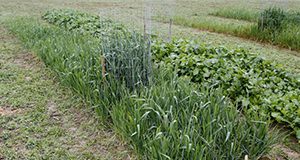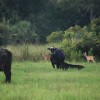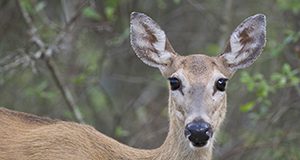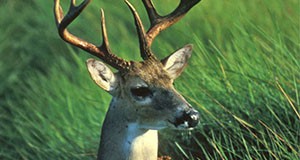The viruses that cause hemorrhagic disease (HD) in deer do not cause illness in people, but they are a growing problem. HD is the most important viral disease of white-tailed deer in the United States. Large outbreaks have occurred in the northern Midwest and western United States. In Florida outbreaks are fewer and less severe in populations of wild white-tailed deer than are outbreaks among wild deer in other areas of the United States, but farm-raised deer in the state are proving vulnerable to epizootic hemorrhagic disease virus: one of the viruses that cause HD. This 6-page fact sheet written by Katherine A. Sayler, Charlotte Dow, and Samantha M. Wisely and published by the Department of Wildlife Ecology and Conservation describes best management techniques for outbreaks of HD in farm-raised deer. It includes strategies for best supportive care for sick animals, diagnostics, and integrated pest management to control biting midges that spread the viruses that cause HD, because the best way to manage HD is to prevent it.
http://edis.ifas.ufl.edu/uw411
Tag: Deer
Temporary Food Plot Deterrents for Deer: Do They Work?

Many Floridians enjoy the opportunity to hunt, watch, or photograph white-tailed deer. Hunters and landowners often plant cool season forage plots both to attract wildlife and to provide a dependable food source. But where there is a high deer population or scarce food resources, deer may forage on food plots as soon as the plants emerge and before they become established. This fact sheet presents the results of research conducted at the UF/IFAS North Florida Research and Education Center in Quincy into the effectiveness of various strategies hunters and landowners can use to temporarily limit access to new food plots until the plants are well established and strong enough to attract and sustain hungry deer through the winter. Written by Holly Ober, Cheryl Mackowiak, and Ann Blount and published by the UF/IFAS Department of Wildlife Ecology and Conservation.
http://edis.ifas.ufl.edu/uw410
Managing Conflicts with Wildlife: Living with Deer
Though deer rarely pose problems for people, it is important to understand the issues associated with deer and human-deer interactions. This 4-page fact sheet describes the biology of Florida’s white-tailed deer, the hazards associated with deer, and how to minimize these risks. Written by William M. Giuliano, Holly K. Ober, Lauren Watine, and Raoul Boughton, and published by the UF Department of Wildlife Ecology and Conservation, December 2014.
http://edis.ifas.ufl.edu/uw398
Tips for Integrating Land and Wildlife Management: Deer in Ranchlands (WEC330/UW375)
 In addition to having generally low-quality foods, ranchlands often have a low diversity of food sources, further reducing the quality of habitat for deer. Ranchland management for deer should therefore focus on providing a diversity of abundant, high-quality foods. This 2-page fact sheet provides some deer habitat improvement tips that focus primarily on raising the quality of deer forage but that also will help you grow better cover by improving plant diversity and productivity. Written by William M. Giuliano, John M. Olson, and Cailey Thomas, and published by the UF Department of Wildlife Ecology and Conservation, January 2013.
In addition to having generally low-quality foods, ranchlands often have a low diversity of food sources, further reducing the quality of habitat for deer. Ranchland management for deer should therefore focus on providing a diversity of abundant, high-quality foods. This 2-page fact sheet provides some deer habitat improvement tips that focus primarily on raising the quality of deer forage but that also will help you grow better cover by improving plant diversity and productivity. Written by William M. Giuliano, John M. Olson, and Cailey Thomas, and published by the UF Department of Wildlife Ecology and Conservation, January 2013.
http://edis.ifas.ufl.edu/uw375
Tips for Integrating Land and Wildlife Management: Deer in Forests (WEC329/UW374)
 Prized by hunters and wildlife enthusiasts alike, white-tailed deer are a popular species found throughout Florida. As such, they are often the focus of management for landowners, managers, and lessees who want to improve deer populations while maintaining other land uses such as timber production. This 2-page fact sheet provides some deer habitat improvement tips that focus primarily on raising the quality of deer forage but that also will help you grow better cover by improving plant diversity and productivity. Written by William M. Giuliano, John M. Olson, and Cailey Thomas, and published by the UF Department of Wildlife Ecology and Conservation, January 2013.
Prized by hunters and wildlife enthusiasts alike, white-tailed deer are a popular species found throughout Florida. As such, they are often the focus of management for landowners, managers, and lessees who want to improve deer populations while maintaining other land uses such as timber production. This 2-page fact sheet provides some deer habitat improvement tips that focus primarily on raising the quality of deer forage but that also will help you grow better cover by improving plant diversity and productivity. Written by William M. Giuliano, John M. Olson, and Cailey Thomas, and published by the UF Department of Wildlife Ecology and Conservation, January 2013.
http://edis.ifas.ufl.edu/uw374
Wildflowers Susceptible to Deer Damage in North Florida (WEC315/UW360)
 One sure way to prevent deer damage to your landscape is to choose plants that deer do not like to eat. Unfortunately deer foraging preferences vary geographically and studies conducted with captive deer aren’t always accurate. So UF/IFAS wildlife researchers investigated the foraging preference of wild white-tailed deer at two sites in Gadsden County with high deer densities for two years. Of 11 wildlfowers tested, four were very susceptible to browsing: fringeleaf tickseed, Florida tickseed, coastalplain tickseed, and orange coneflower. This 4-page fact sheet was written by Holly K. Ober, Lucas W. DeGroote, James H. Aldrich, Jefferey G. Norcini, and Gary W. Knox , and published by the UF Department of Wildlife Ecology and Conservation, December 2011.
One sure way to prevent deer damage to your landscape is to choose plants that deer do not like to eat. Unfortunately deer foraging preferences vary geographically and studies conducted with captive deer aren’t always accurate. So UF/IFAS wildlife researchers investigated the foraging preference of wild white-tailed deer at two sites in Gadsden County with high deer densities for two years. Of 11 wildlfowers tested, four were very susceptible to browsing: fringeleaf tickseed, Florida tickseed, coastalplain tickseed, and orange coneflower. This 4-page fact sheet was written by Holly K. Ober, Lucas W. DeGroote, James H. Aldrich, Jefferey G. Norcini, and Gary W. Knox , and published by the UF Department of Wildlife Ecology and Conservation, December 2011.
http://edis.ifas.ufl.edu/uw360
Establishing and Maintaining Wildlife Food Sources (SSFOR12/FR062)
 Provide abundant and varied food sources for wildlife on your forested land, with this 5-page fact sheet written by Chris Demers, Alan Long, Chris Latt, and Emma Willcox, and published by the UF Department of School of Forest Resources and Conservation, May 2011.
Provide abundant and varied food sources for wildlife on your forested land, with this 5-page fact sheet written by Chris Demers, Alan Long, Chris Latt, and Emma Willcox, and published by the UF Department of School of Forest Resources and Conservation, May 2011.
http://edis.ifas.ufl.edu/fr062

